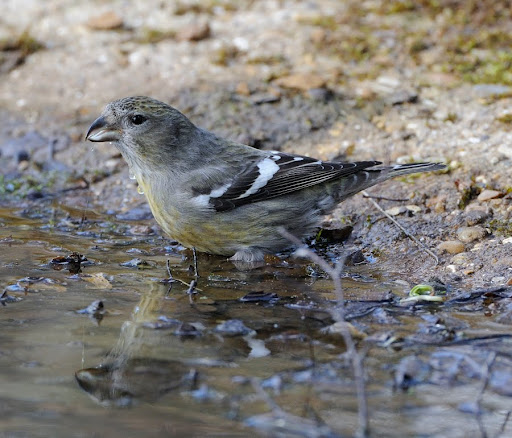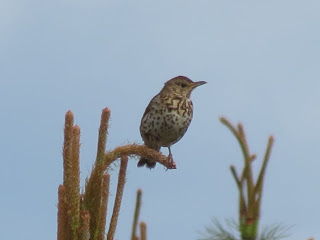WEDNESDAY 15 MAY
Lots of rain overnight leading to some localised flooding with showers persisting throughout the morning and into early afternoon. During this period, the temperature struggled to get higher than 4 degrees C, incredibly unusual for this late in May. The sun started shining at 1500 hours and temperatures did then recover to 12 degrees C.
My first port of call was WILSTONE RESERVOIR (HERTS) where a Sanderling had been seen flying around early morning (per Paul Reed). There was no sign of it when I arrived at 0800 hours, in fact there was very little of anything other than EUROPEAN BARN SWALLOWS........
I carefully checked through them for a Red-rumped but there was no immediate sign and a click-count from the jetty revealed the presence of no less than 433 hawking back and forth over the reservoir, an exceptional number so late in the spring. There was a surprisingly low number of Common Swifts - just 55 - whilst House Martins peaked at 32 - whilst other migrants included a male YELLOW WAGTAIL on the east bank and 5 Pied Wagtails near the car park.
At nearby MARSWORTH RESERVOIR, another 80 BARN SWALLOWS were logged, many taking to sheltering in the reeds due to the cold and wet. A drake Gadwall was also present, as well as 6 Great Crested Grebes, with 15 or so Western Reed Warblers singing from the reeds.
STARTOP'S END RESERVOIR held even more incredible numbers of BARN SWALLOWS - a bare minimum of 713 birds - as well as 168 HOUSE MARTINS. The latter were in a terrible state, taking refuge on the bank (see photographs below) and I worried for their welfare.
On the water, 2 drake Gadwall, a Mute Swan, 4 Great Crested Grebes, 16 Coot, a drake Northern Pochard and two pairs of RED-CRESTED POCHARD were present, with both Greylag Geese and Atlantic Canada Geese pairs accompanying 3 goslings a piece. In the car park, the Carrion Crow was still incubating and a pair of Greenfinch were prospecting, with a Grey Wagtail on the west shore and 4 migrant YELLOW WAGTAILS in the horsefield at STARTOP FARM.
Replacing Francis Buckle in the main hide at COLLEGE LAKE BBOWT gave me the opportunity to photograph the 6 summer-plumaged DUNLIN that had arrived early morning but both Paul and Francis confirmed that the Wilstone Sanderling had not relocated here. Other waders present included singles of both Ringed and Little Ringed Plovers, the Oystercatcher pair and 5 Common Redshank, whilst Common Terns had increased to 27 and showed signs of real interest in nesting. The two COMMON SHELDUCKS were both present, with Mute Swans down to 12.
Stuart Warren then found another SANDERLING and this one was sticking and part of a major arrival of passage waders at BROOM GYPSY LANE EAST PITS in Bedfordshire. I decided to make a move that way, arriving just as Lol Carman and John Temple were leaving. The wader flock were still in situ and comprised of 3 summer-plumaged TURNSTONES, a winter-plumaged SANDERLING, 23 Ringed Plover (including several considered to be of the Arctic form tundrae), 6 Dunlin and 4 Little Ringed Plover. I took over 100 photographs of the Turnstone and Sanderling (see selection below). Not much else present though, with the Mute Swan nest still active, 2 adult Lesser Black-backed Gulls and an impressive 10 Common Shelducks.
In AMPTHILL at the BOWLING GREEN, the male COMMON NIGHTINGALE was singing away from at least 1400-1415 hours, whilst in WOBURN PARK, two drake MANDARIN DUCKS were on the lake by the gatehouse.
Half an hour later, the sun came out and temperatures recovered to 12 degrees C. I joined Jeff Bailey at STARTOPSEND RESERVOIR and we did a sweep of the site. This time, with large numbers of insects on the wing, COMMON SWIFTS were dominating, with perhaps 1,000 birds in all. A Common Redshank was also present, whilst 5 HOBBIES appeared from nowhere and began hunting the Buckinghamshire stretch of the bank. On neighbouring MARSWORTH, the CETTI'S WARBLER sang from the reedbed.
BOVINGDON BRICKPITS (HERTS) this evening yielded both BULLFINCH and COMMON WHITETHROAT, with 3 Common Buzzards and a Red Kite overhead and two Common Chiffchaffs singing




















































